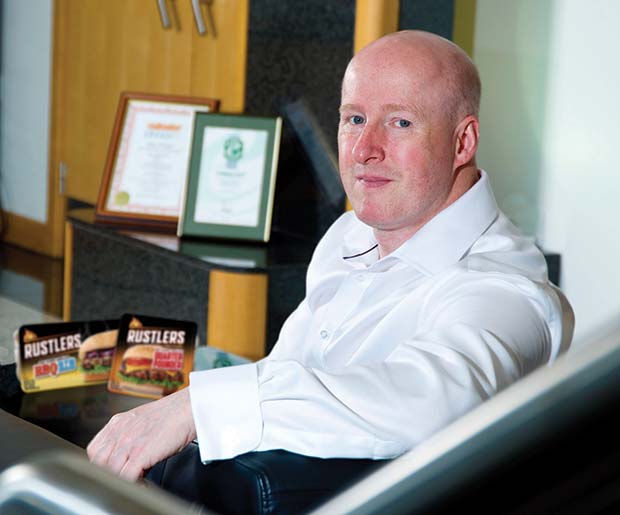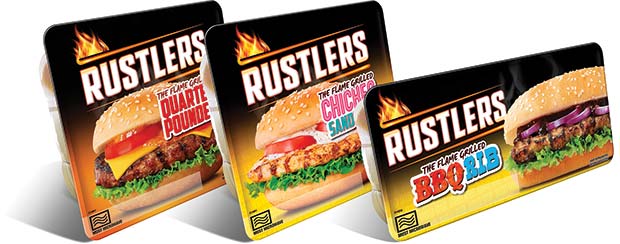Rustlers, the market leading microwaveable snacking brand from Kepak Convenience Foods, has become something of a grocery icon over the last decade or so. In 2015 it continues to maintain outright leadership of the £120 million ‘micro-snacking’ market, which is currently growing at 4% per annum.

The biggest news from Rustlers is, it has come of age, with 40% of Rustlers consumers now female and the consumer age range broadening to 18-35. After a decade of being a serious “lads” product, with suitably laddish advertising and online promotion to match, we won’t be seeing any more “fit as a butcher’s dog” stories in their social media activity. But that doesn’t mean Rustlers is opting for early retirement. Not by any means. It’s another big year for Rustlers, with new packaging, the launch of a new Rustlers-branded Panini range backed by nationwide sampling, TV advertising and what the company describes as its biggest on-pack promotion yet. And unlike many grocery companies Rustlers is seriously embracing social media, with impressive results.
John Armstrong, Marketing Director at Kepak Convenience Foods, spoke to The Grocery Trader.
The Grocery Trader – John, we last spoke about a year ago. What have the last 12 months been like for Kepak?
Business wise we’ve seen good growth, and profitability is going in the right direction. We’ve had a change of CEO with Simon Walker coming in, after being in charge of our European business. We’re refocusing on growing the core business and getting back to our strengths – the Rustlers brand, our channel knowledge and understanding the consumer better than anyone.
GT – Not very long ago you were talking in the trade press in excited terms about the ‘Hot Quick & Tasty’ concept, and making the case for retailers to present a clutch of different product categories in their chillers as ‘Hot Quick & Tasty,’ to energise sales in their stores. How is that going?
The ‘HQT’ concept of how consumers use these products is still valid and we continue to use it in our selling, but execution in store can be challenging. ‘HQT’ works fine in convenience stores, where the same buyer does it all, but in big stores, it’s not as straight-forward. We’re still presenting ‘HQT’ as the backdrop to our business, but we’re more focused now on micro snacking at the fixture.
GT – So if you’re not talking about ‘HQT’ now, how else are you encouraging retailers to be competitive with these products in store?
We mainly work on the Omnichannel theme, making sure we’re sweating every channel – online, convenience or front of store, there’s still plenty of opportunity. The very nature of what we’re selling is that you buy it where you find it hence “thinking Omnichannel” is vital. Beyond Omnichannel, we’re preaching about getting the value balance right – the Rustlers headline price kept creeping ahead of the key threshold of £2. Getting our products down to £2 or below helps to sell more off the deal price. We’re in a deflationary food market, where price thresholds are critical.
GT – What are the trends in the chilled sector overall?
Chilled convenience is still one of the biggest areas in convenience. It’s a battleground, with the discounters outdoing the big retailers, who are reacting in order to keep up. It’s also evident that the convenience channel has upped its game in chilled.

GT – Where is the 4% growth in the microwaveable snacking market coming from?
The growth has come from people buying more – the challenge now is to bring more shoppers into the category. People are buying more frequently, and the market’s got more reach, for example online growth is particularly strong. We’re seeing good growth in Sainsbury’s. Tesco is still in double-digit growth. In ASDA, Feasters is up 7.2%, and we’ve been concentrating on getting the product, value, range and distribution right. We’ve also made headway inside the M25, which is always a challenge, and we’ve now got four or five big local van sellers on board.
GT – This figure you quote of 40% of Rustlers consumers now being female is one heck of a shift! How has it come about?
It’s really more of a change of focus than a shift. The female proportion has been around 40% for five or six years, but now we’re doing something about addressing it. Our advertising these days is less laddish: it’s still showing a male tone of voice but is more inclusive of women, like beer ads are these days.
GT – Which other brands besides Rustlers are in the micro-snacking market, as you define it?
There’s really only one other significant player out there, Taste Inc, which is now just in Morrisons. There are some tertiary brands in pockets of the convenience sector and various Dutch brands shipped into the UK with imported flowers. The Dutch brands sell on their price and long shelf life, but their quality is somewhat unreliable. Given the recent food issues, this isn’t an area where retailers can afford to play fast and loose.
GT – With the new Rustlers repositioning, how has the packaging changed?
We’re selling the taste proposition more. Historically we’ve tended to undersell it, but the recent research shows people are into the taste, so the packaging focuses on that. The design brief is ‘more taste, less speed.’ There’s also the need to distinguish Rustlers from the competition and underline the brand leader credentials. The new packaging is out there, and it’s been well received.
GT – What products are in the Rustlers range now?
The Rustlers range is heavily burger-centric, which is what made us famous. It includes the best-selling quarter pounder, the chicken sandwich, BBQ Rib, a deluxe product with bacon, two new Panini products which came out in June, a Rustlers Southern Fried Sub, a line up that reflects the tastes people enjoy in food to go outlets.
 GT – You mentioned the new Rustlers Panini. What are they like?
GT – You mentioned the new Rustlers Panini. What are they like?
There are two variants, Chicken & Pesto and Pepperoni. The bread is stone baked ciabatta, delivered with wraparound sleeve technology, mirroring popular products in Starbucks and Costa, which is incidentally the second biggest foodservice outlet after McDonalds and a big influence on consumer tastes. There’s already evidence that these products are bringing in 25-34s and attracting more female consumers, and adding to our strength in the lunch area.
GT – What’s happened to the other Panini you used to make, ZUGO’s?
We’ve retired them. We had to make an investment choice: we had ZUGO’s for eight years but couldn’t afford to drive two brands. It was a painful decision but needed to be done. There’s still plenty of headroom in Rustlers, and that’s our focus.
GT – While we’re talking about brands, what happened to Speedy Snacks and Feasters?
Speedy Snacks have had a good last three years, at a time when people’s wallets were more pressured. We’ve been recruiting consumers in Tesco since June with single packs and Every Day Low Pricing. Speedy Snacks is a very different proposition to Rustlers, and sales are up 20% year on year. Feasters is an exclusive brand to ASDA; sales are up 7% off a high base and running at their highest ever rate. Our initiatives to support them include multi-buy development and revamping the packaging to emphasise quality and taste. ASDA is keen on driving Feasters sales online, and we will be working with them to develop this area.
GT – How are you promoting the new Rustlers Panini?
We’ve just done a nationwide lunch hot spot tour in major cities, giving out 90,000 products, and a ‘Free for every reader’ offer in the Daily Star. We’re also running price promotions and loyalty card-based coupons at the till to convert former ZUGO’s shoppers. We have also carried out a social media conversion campaign, telling consumers about the move from ZUGO’s to Rustlers, supported with on-pack stickering for the transformation over an eight-week period.
GT – With the shift away from Rustlers’ old laddish positioning, what will the tone and content of the above the line activity be like now?
The Satisfy Your Hunger Monkey theme is still there. It has more of a focus on taste and is more unisex, but still appeals to our original core audience, 16-24 males. You can’t be too ‘vanilla’ talking to them! We’re also doing other things such as our Terminator partnership. We ran a 20 second ad with a 5-second sting announcing the link-up on digital TV channels and social media, achieving a 2 million reach. In London we’ve had actors dressed as cyborgs on the tube. We started the Terminator on-pack four weeks before the film broke. This social media traction is one of the most successful things we’ve done, fuelled by the sheer level of hype around the film from Arnie and the franchise. Rustlers has matured as a brand, but it still talks predominantly to 16-24s and seeks to entertain. It needs to stand out.
GT – What are you doing with social media to drive Rustlers forward?
Social media as a media tool has become more of a reality in the last few years. We run video ads on Facebook and Twitter. The nature of the beast means social media is fantastic for targeting consumers about what we do. It generates great engagement and a fast response on how people see the product – it’s a really good listening tool. With media planning you go where the eyeballs are, hence the benefit of working with top agencies. Just 12 months ago Twitter wasn’t great for 16-24s, it was hitting the 45 plus age group, but now 16-24s are using it to chat about TV and sport and it’s a good medium to talk to them.
GT – Where do you see the UK micro snacking market going from here?
There will always be cheap European imports, but they won’t make much headway. The likes of Taste Inc will always exist; our job is to remind retailers that we’re best-placed at growing the market in the long term.
Our product strength is flame-grilled technology – the key is unlocking taste, and we need to do more. Selling more burgers is still the best thing for us to invest money in. A number of brands build a business on either one or a few core products, and Kepak is one of those and proud of it. The market is much more conservative now; the big retailers have been entrenching with a revolving door of people at the top, and are looking for brands which can offer sound category knowledge – they’re more willing to listen to suppliers who can help them build a business.
GT – Finally, what are your plans and expectations for the Rustlers brand going forward?
We’re working on a three-year brand roadmap in which the key job is making people aware of Rustlers’ taste and quality. We do well with our core audience, but still only reach one in four of them. We also need to reach more retail outlets – the convenience channel has always been very important for us, and in the top 3,500 stores we are now in over 40%. In retail it’s less about highlighting product availability and more about persuading potential stockists about Rustlers’ strong rate of sale, getting them to start by stocking the quarter pounder, then the chicken sandwich and building their confidence. There’s plenty of scope for us to keep the brand energised in years to come.
Rustlers




Comments are closed.